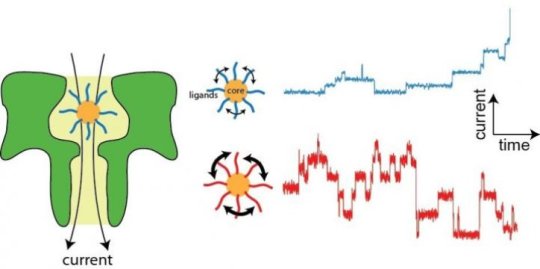[ad_1]
Researchers in Virginia Commonwealth University’s Department of Physics have discovered that a technique known as nanopore sensing can be used to detect subtle changes in clusters, or extremely small chunks of matter that are bigger than a molecule but smaller than a solid.
“Nanopores act as extremely small volume sensors that are on the order of a few nanometers a side,” said Joseph Reiner, Ph.D., an associate professor of experimental biophysics and nanoscience in the College of Humanities and Sciences. “This size scale allows us to observe when the cluster changes size by a single ligand molecule. The ability to detect these changes in real time — as they happen — to a single cluster particle is the new and exciting thing here.”
The discovery is described in a paper, “Ligand-induced Structural Changes of Thiolate-capped Gold Nanoclusters Observed with Resistive-pulse Nanopore Sensing,” by Reiner and physics professor Massimo F. Bertino, Ph.D., along with VCU students Bobby Cox, Peter Wilkerson and Patrick Woodworth, published in the Journal of the American Chemical Society.
“This is new because there really aren’t many ways to detect these changes on a single particle in real time,” Reiner said. “This opens the door to observe all kinds of interesting phenomenon on nanosurfaces, which is an area of great interest to many chemists in both applied and pure research areas.”
The research sheds new light on the activity of clusters, which are extremely reactive objects and are considered to be interesting for catalysis, or the acceleration of a chemical reaction by a catalyst.
“Understanding how molecules behave on a nanocluster helps [our] understanding of their catalytic properties,” Bertino said. “To date, people thought that molecules were kind of stationary on cluster surfaces. Our experiments show that molecules, instead, change their configuration and position at a very fast pace. This opens new perspectives for the chemistry of these things.”
The team’s findings could lead to exciting new discoveries, Bertino said.
“There are several possible alleys that open now. One is to look at cluster growth. Nobody has a good grasp on how these things come into existence. Another one is to help tune their properties,” he said. “To date, people grow these things and make them reactive, but it’s not always clear how this happens. Essentially, darts are thrown at the problem and one hopes that one of them sticks. This work allows us to look at a single cluster of a well-defined size and lets us mess with it by varying one parameter at a time.”
By getting a better look at these clusters and how they behave, the researchers hope to gain a better understanding of how catalysts could be improved for more efficient drug discovery and synthesis.
Story Source:
Materials provided by Virginia Commonwealth University. Note: Content may be edited for style and length.
[ad_2]















